
Élisabeth Louise Vigée Le Brun, also known as Madame Le Brun and Louise élisabeth vigee Le Brun, was a French painter who mostly specialized in portrait painting, in the late 18th and early 19th centuries.

Marie Antoinette was the last queen of France before the French Revolution. She was born an archduchess of Austria, and was the penultimate child and youngest daughter of Empress Maria Theresa and Emperor Francis I. She became dauphine of France in May 1770 at age 14 upon her marriage to Louis-Auguste, heir apparent to the French throne. On 10 May 1774, her husband ascended the throne as Louis XVI and she became queen.

Jeanne Antoinette Poisson, Duchesse de Pompadour, commonly known as Madame de Pompadour, was a member of the French court. She was the official chief mistress of King Louis XV from 1745 to 1751, and remained influential as court favourite until her death.

Jeanne Bécu, Comtesse du Barry was the last maîtresse-en-titre of King Louis XV of France. She was executed by guillotine during the French Revolution on accusations of treason—particularly being suspected of assisting émigrés to flee from the Revolution.

Louveciennes is a commune in the Yvelines department in the Île-de-France region in north-central France. It is located in the western suburbs of Paris, between Versailles and Saint-Germain-en-Laye, and adjacent to Marly-le-Roi.

"Let them eat cake" is the traditional translation of the French phrase "Qu'ils mangent de la brioche", said to have been spoken in the 18th century by "a great princess" upon being told that the peasants had no bread. The French phrase mentions brioche, a bread enriched with butter and eggs, considered a luxury food. The quote is taken to reflect either the princess's frivolous disregard for the starving peasants or her poor understanding of their plight.
Maggie Steed is an English actress and comedian.
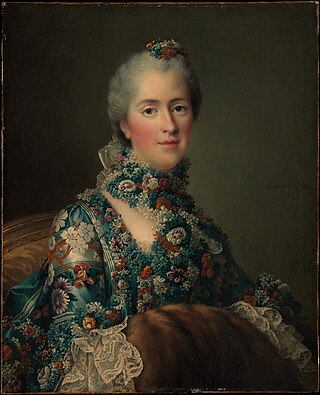
François-Hubert Drouais was a leading French portrait painter during the latter years of Louis XV's reign. His clientele included the French royal family and nobility, foreign aristocracy, fermiers-généraux, and the wealthier members of Parisian society and their favourites. But it was his increasing popularity at the French court that expanded his clientele and made his portraits a fashionable necessity. Drouais’s work was admired during his lifetime, and his popularity and clientele did not diminish from the occasional adverse judgement published in Salon reviews.
Elizabeth Berrington is an English actress and graduate of the Webber Douglas Academy of Dramatic Art; she is best known for her roles as Ruby Fry in Waterloo Road, Paula Kosh in Stella, Mel Debrou in Moving Wallpaper, and Dawn Stevenson in The Syndicate. She has also featured in British television series such as The Bill, Doctor Who, The Office, Casualty, The Lakes, The Grimleys, and Rose and Maloney.

Marie Joséphine of Savoy was a princess of France and countess of Provence by marriage to the future King Louis XVIII of France. She was regarded by Bourbon Royalist Legitimists as the titular 'queen of France' when her husband assumed the title of king in 1795 upon the death of his nephew, the titular King Louis XVII of France, until her death. She was never practically queen, as she died before her husband actually became king in 1814.
Adrian Philip Scarborough is an English actor.
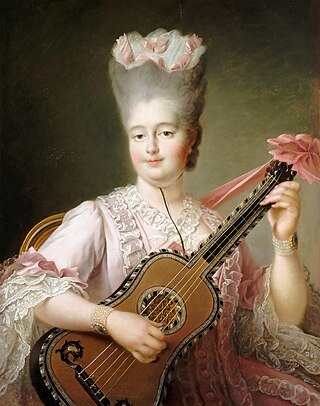
Marie Clotilde of France, known as Clotilde in Italy, was Queen of Sardinia by marriage to Charles Emmanuel IV of Sardinia. She was the younger sister of Louis XVI of France. She was politically active and acted as the de facto first minister of her spouse during his reign. She is venerated in the Catholic Church, having been declared Venerable by Pope Pius VII.

Joseph Hyacinthe François de Paule de Rigaud, comte de Vaudreuil was a Saint Dominican nobleman at the court of King Louis XVI of France. He was the alleged lover of Gabrielle de Polastron, duchesse de Polignac, the favourite of Marie Antoinette and over whom he exerted a powerful influence.
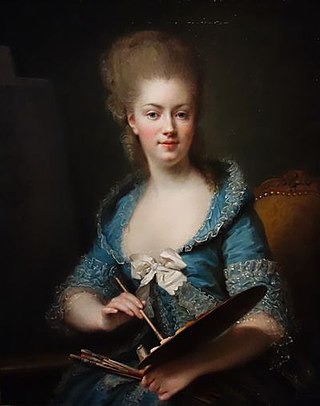
Rosalie Filleul was a French pastellist and painter. She was born in Paris, and was concierge of the Château de la Muette. Although she initially supported the French Revolution, she nevertheless became disillusioned by its excesses and mourned the execution of Louis XVI. Somewhat indiscreetly, at the height of the Terror, she made arrangements to sell some of the furniture at the Château de la Muette to a secondhand dealer. This was reported to the authorities and she was arrested on charges of theft and concealment of biens nationaux – property belonging to the Republic. Rosalie Filleul was found guilty and guillotined in 1794, along with her friend Mme Chalgrin, despite the attempted intervention of Chalgrin's brother Carle Vernet.

Queen Marie Antoinette of France is best remembered for her legendary extravagance and her death: she was executed by guillotine during the Reign of Terror at the height of the French Revolution in 1793 for the crime of treason. Her life has been the subject of many historically accurate biographies and the subject of romance novels and films.
Pauline de Tourzel was a French noblewoman, courtier and memoirist. She was the daughter of Louise-Élisabeth de Tourzel.
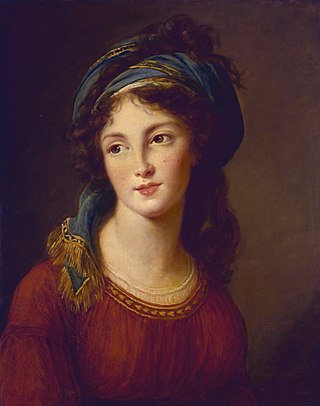
Aglaé Louise Françoise Gabrielle de Polignac was the daughter of Gabrielle de Polastron, the favourite and confidante of Marie Antoinette, and her husband, the 1st duc de Polignac.

Mary Diana Lee Sheriff was an American art historian, and W.R. Kenan, Jr. Distinguished Professor of Art History at University of North Carolina at Chapel Hill who specialized in eighteenth-century French art, decorative arts, gender studies, and material culture.
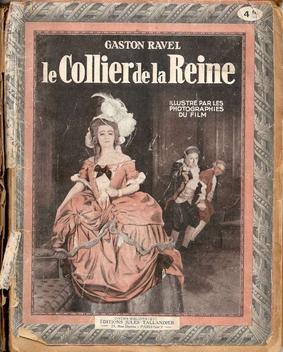
The Queen's Necklace is a 1929 French historical drama film directed by Tony Lekain and Gaston Ravel and starring Marcelle Chantal, Georges Lannes and Diana Karenne. The film is an adaptation of Alexandre Dumas's novel The Queen's Necklace which portrays the Affair of the Diamond Necklace which occurred before the French Revolution. The film's art direction was by Lucien Carré. The film was made and distributed by Gaumont. In Germany it was released by the major studio UFA.
Marie Célestine Amélie d'Armaillé was a French writer, biographer, and historian. In 1887, she was a recipient of the Montyon Prize from the Académie Française, for the biography, Madame Élisabeth, sœur de Louis XVI. Armaillé died in 1918.















